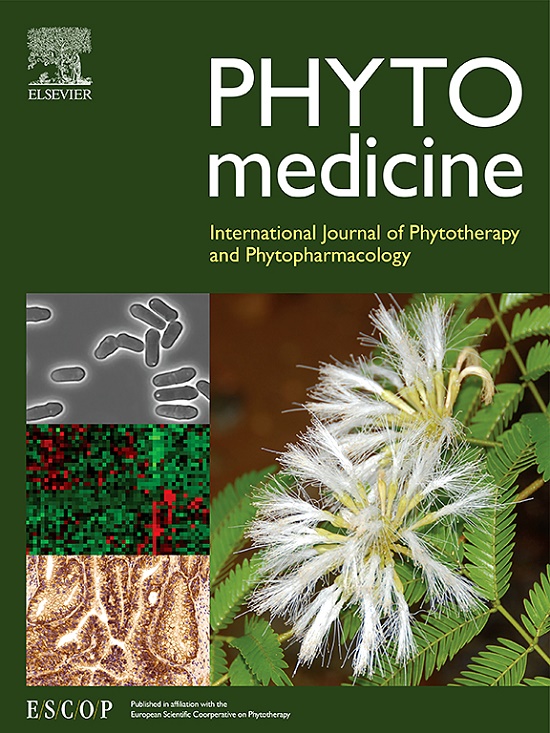葛根素对糖尿病肾病的保护作用:动物研究的系统回顾和荟萃分析。
IF 6.7
1区 医学
Q1 CHEMISTRY, MEDICINAL
引用次数: 0
摘要
背景:葛根素是从中国草本植物葛根中分离出来的重要成分。哦,它具有多种生物活性。已有研究表明葛根素具有减轻糖尿病肾病(DN)动物模型肾损害的作用。然而,目前仍缺乏系统的临床前研究。目的:本研究旨在通过荟萃分析评估葛根素对DN的疗效。此外,本研究旨在揭示葛根素治疗DN的作用机制。方法:从5个电子数据库中检索动物实验。我们的分析共纳入了26项研究。采用STATA 18.0软件评估关键参数,包括空腹血糖(FBG)、血清肌酐(SCr)、血尿素氮(BUN)、蛋白尿、氧化应激、炎症反应和脂质代谢。结果:葛根素显著改善大鼠空腹血糖、SCr、BUN、蛋白尿及肾指数(KI)。此外,葛根素增强氧化应激指标,包括超氧化物歧化酶(SOD)、谷胱甘肽(GSH)和过氧化氢酶(CAT),同时降低炎症指标,如白细胞介素6 (IL-6)、白细胞介素1β (IL-1β)和肿瘤坏死因子α (TNF-α)。此外,葛根素降低甘油三酯(TG)、总胆固醇(TC)和低密度脂蛋白胆固醇(LDL)水平。结论:综上所述,葛根素可能通过抗氧化、抗炎、调节肾脂质积累等途径改善DN动物肾功能,为其治疗DN提供临床前支持。本文章由计算机程序翻译,如有差异,请以英文原文为准。

Protective effect of puerarin in diabetic nephropathy: A systematic review and meta-analysis of animal studies
Background
Puerarin is a crucial constituent separated from the Chinese herbaceous plant, Pueraria lobata (Willd.) Ohwi, which exhibits multiple biological activities. Previous studies have indicated that puerarin has a function to alleviate renal damage in animal models of diabetic nephropathy (DN). However, there is still a dearth of systematic preclinical studies.
Purpose
This study was designed to assess the effectiveness of puerarin on DN through meta-analysis. Furthermore, it aimed to reveal the underlying mechanisms of puerarin's efficacy in treating DN.
Methods
The animal studies were retrieved from 5 electronic databases. In total, 26 studies were included in our analysis. STATA 18.0 software was employed to evaluate crucial parameters, including fasting blood glucose (FBG), serum creatinine (SCr), blood urea nitrogen (BUN), proteinuria, oxidative stress, inflammatory responses, and lipid metabolism.
Results
The results indicate that puerarin significantly improves FBG, SCr, BUN, proteinuria, and kidney index (KI). Additionally, puerarin enhances indicators of oxidative stress including superoxide dismutase (SOD), glutathione (GSH), and catalase (CAT), while reduces inflammatory indicators like interleukin 6 (IL-6), interleukin 1β (IL-1β), and tumor necrosis factor alpha (TNF-α). Moreover, puerarin lowers triglycerides (TG), total cholesterol (TC), and low-density lipoprotein cholesterol (LDL) levels.
Conclusion
In conclusion, puerarin has the effect of improving renal function in DN animals possibly through antioxidative, anti-inflammatory, and the regulation of renal lipid accumulation, which offers preclinical support for its possible therapeutic use in the management of DN.
求助全文
通过发布文献求助,成功后即可免费获取论文全文。
去求助
来源期刊

Phytomedicine
医学-药学
CiteScore
10.30
自引率
5.10%
发文量
670
审稿时长
91 days
期刊介绍:
Phytomedicine is a therapy-oriented journal that publishes innovative studies on the efficacy, safety, quality, and mechanisms of action of specified plant extracts, phytopharmaceuticals, and their isolated constituents. This includes clinical, pharmacological, pharmacokinetic, and toxicological studies of herbal medicinal products, preparations, and purified compounds with defined and consistent quality, ensuring reproducible pharmacological activity. Founded in 1994, Phytomedicine aims to focus and stimulate research in this field and establish internationally accepted scientific standards for pharmacological studies, proof of clinical efficacy, and safety of phytomedicines.
 求助内容:
求助内容: 应助结果提醒方式:
应助结果提醒方式:


